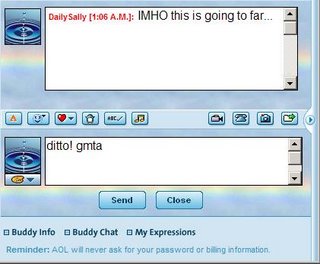AP AOL IMs - BFD

"Last year, instant messaging was the sleeping giant, and companies were literally asleep at the wheel. This year, people are awakening to the problem, but haven't necessarily come up with solutions." Jon Sakoda
AOL and AP have released a joint survey claiming that 72 percent of IMing teens send each other more IMs than emails, as opposed to 26 percent of adults.
But wait. There's more.
According to the survey, most teens also send photos, music and videos in their IMs.
And here comes the Big One.
Fully 30 percent of teens say they can't imagine life without IMing. (Only 17 percent of adults feel that way.)
Well. I don't know what to say. Actually, yes I do ... DUH!
Anyone with a brain is aware of the love affair between today's teens and the online culture. We don't need a survey to tell us the obvious and neither should AOL. That culture may open a door to the whole planet for kids, but it also closes down their communication skills.
Pay attention to how teens interact with each other. You'll rarely hear more than five spoken words at a time. Mostly consisting of 'yo', 'what's up', 'like', 'dude', and 'sweet.' And in IMs, acronyms rule. RU there? Want 2 meet? A/S/L? (Age/Sex/Location)
Sadly, too many teens think, speak and write in bites. They rarely even talk on their ubiquitous cell phones. They send cryptic text messages instead. Texting and IMing are the ultimate 21st century tools for this generation's disengaged, short attention span lifestyle.
In the adult world email is as much a necessary part of daily personal and professional life as the telephone. Few people or businesses could manage without it.
But for teens, sending an email takes time, effort ... and syntax. You have to look up the address. Open with some sort of address. Type actual sentences that make actual sense. Close with confidence. And then wait who knows how long--if ever--for a reply. It's a risk, outreach sans instant payback.
Instant Messages--as the name implies--are fast. Virtually effortless. They require very little thought. Offer instant gratification. And validation. PING! Somebody knows I exist. Brrring! I'm popular!
And there's the rub. Popularity online is relative. And potentially very dangerous.
This is the survey finding that scares me:
More than half of adult male IM users (51 percent) send instant messages to people they’ve never met in person, compared with 35 percent of females. Thirty-nine percent of teens have sent an IM to someone they’ve never met in person.I know AOL's goal with this survey is to trumpet--justifiably--the pivotal role IMs play in today's society.
But in the wrong hands for the wrong reasons, IMs can lead our children into harm's way. If nothing else, this survey should be a wake-up call to parents to more closely monitor the content of their teens' IMs -- and make sure they know who's on the other end.
It only takes a few Pings and Brrrings to spell trouble for today's kids. IMs fly through cyberspace with little, if any accountability. There are too often no real conversations before teens 'hook up' with someone they've met via IMs. How can you get to know someone when you communicate in acronyms and abbreviations?
When our kids are young and first acting out we say to them, Use your words. What we additionally mean is Use your brains. If only we could get them do both now.
Labels: Media Musings







0 Comments:
Post a Comment
<< Home